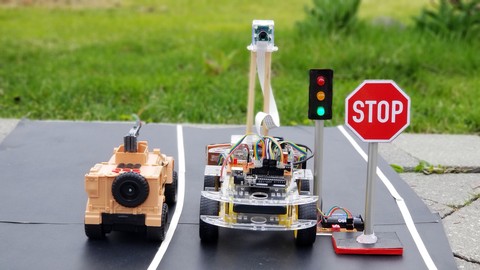
Build your Own Self Driving Car| [Course 1 & Course 2]
Build your Own Self Driving Car| [Course 1 & Course 2], available at $24.99, has an average rating of 3.8, with 82 lectures, based on 102 reviews, and has 542 subscribers.
You will learn about Learn How to Setup Raspberry Pi 3 for any IOT Project Learn How to Setup Arduino UNO as a Slave micro-controller for any IOT Project Learn Image Processing using OpenCV4 for any Platform Learn Machine Learning & Train your own Image Classifier Learn How to Troubleshoot any Hardware & Software issues Most Important!! Learn to Design Embedded Product totally from scratch This course is ideal for individuals who are College or University student from Electronics/Electrical or Computer Engineering or relevant Diploma or Hobbyist interested in Machine Learning & Image Processing or Anybody Who wants to create Embedded IOT Project It is particularly useful for College or University student from Electronics/Electrical or Computer Engineering or relevant Diploma or Hobbyist interested in Machine Learning & Image Processing or Anybody Who wants to create Embedded IOT Project.
Enroll now: Build your Own Self Driving Car| [Course 1 & Course 2]
Summary
Title: Build your Own Self Driving Car| [Course 1 & Course 2]
Price: $24.99
Average Rating: 3.8
Number of Lectures: 82
Number of Published Lectures: 82
Number of Curriculum Items: 82
Number of Published Curriculum Objects: 82
Original Price: CA$32.99
Quality Status: approved
Status: Live
What You Will Learn
- Learn How to Setup Raspberry Pi 3 for any IOT Project
- Learn How to Setup Arduino UNO as a Slave micro-controller for any IOT Project
- Learn Image Processing using OpenCV4 for any Platform
- Learn Machine Learning & Train your own Image Classifier
- Learn How to Troubleshoot any Hardware & Software issues
- Most Important!! Learn to Design Embedded Product totally from scratch
Who Should Attend
- College or University student from Electronics/Electrical or Computer Engineering or relevant Diploma
- Hobbyist interested in Machine Learning & Image Processing
- Anybody Who wants to create Embedded IOT Project
Target Audiences
- College or University student from Electronics/Electrical or Computer Engineering or relevant Diploma
- Hobbyist interested in Machine Learning & Image Processing
- Anybody Who wants to create Embedded IOT Project
“Machine Learning will change the lives of all of us. What is Machine Learning? It’s behind what makes self-driving cars a reality”
This unique course is a complete walk-through process to Design, Build and Program a Embedded IOT Project (Self driving Car). Everything is discussed with details and clear explanation. The complete Self driving Car project is divided into 2 Parts
Part-1: (Course – 1)
1. Learn to design complete hardware for self driving car
a. Learn to setup Master device ( Raspberry Pi 3 ) for any project
b. Learn to setup Slave device ( Arduino UNO ) for any project
c. Learn to Establish Communication link between Master and Slave device
2. Learn Image Processing using OpenCV4
3. Learn to driver robot on road lane
Part-2: (Course – 2)
1. Learn Essentials of Machine Learning
2. Learn to train your own cascade classifier to detect Stop Sign, Traffic Lights and any Object
3. Learn to design LED Dynamic Turn Indicators
“Machine Learning will change the lives of all of us. What is Machine Learning? It’s behind what makes self-driving cars a reality”
This unique course is a complete walk-through process to Design, Build and Program a Embedded IOT Project (Self driving Car). Everything is discussed with details and clear explanation. The complete Self driving Car project is divided into 2 Parts
Course Curriculum
Chapter 1: Introduction
Lecture 1: Course Curriculum
Lecture 2: Detailed Working
Chapter 2: Build Hardware for Self Driving Car
Lecture 1: Hardware Requirements (hardware Link is provided in Resource Section)
Lecture 2: Assemble Hardware Parts (Robot Chassis)
Lecture 3: How To Build Track for Testing
Chapter 3: Slave Device Setup (Arduino UNO)
Lecture 1: Forward & Backward Functions for Motors
Lecture 2: Left & Right Functions for Motors
Chapter 4: Master Device Setup (Raspberry PI 3 B+)
Lecture 1: How to Flash Raspbian OS on Raspberry Pi 3 B+
Lecture 2: Raspbian Buster Fix
Lecture 3: Connect Raspberry PI to Personal Computer through Ethernet
Lecture 4: Connect Raspberry PI to Personal Computer through WiFi
Lecture 5: Connect Raspberry PI to Personal Computer through VNC Viewer
Chapter 5: Install OpenCV4 on Raspberry PI 3 B+
Lecture 1: Introduction to OpenCV
Lecture 2: Remove Unnecessary Software from Raspberry PI
Lecture 3: Clone OpenCV from GitHub
Lecture 4: Build OpenCV on Raspberry PI with CMake
Lecture 5: Setting Up Libraries in Programming Editor
Lecture 6: Test First Program In Geany Programming Editor
Lecture 7: SD CARD BACKUP
Chapter 6: Camera Setup for Raspberry PI
Lecture 1: Install Raspicam & Wiring PI Libraries on Raspberry PI
Lecture 2: Mount Camera on Robot Car Chassis
Lecture 3: Backup of SD Card
Chapter 7: C++ Code to Capture Images & Videos
Lecture 1: How to Initialize Camera
Lecture 2: C++ Code to Capture Images
Lecture 3: C++ Code to Capture Video
Lecture 4: calculate FPS (Frames Per Second)
Chapter 8: Image Processing Using OpenCV4 & C++
Lecture 1: Convert Image Signature
Lecture 2: Create Region Of Interest
Lecture 3: Perspective Transformation (Bird Eye View)
Lecture 4: Threshold Operations
Lecture 5: Canny Edge Detection
Lecture 6: Troubleshoot Hardware & Software
Lecture 7: How to Find Lanes from Track
Lecture 8: Histogram and Vectors
Lecture 9: Iterators and Pointers
Lecture 10: Calibration
Lecture 11: Final Step
Chapter 9: Master & Slave Device Communication
Lecture 1: Raspberry PI Digital Pins
Lecture 2: Wiring Pi Library Fix (download latest command list in resource)
Lecture 3: Slave Device (Arduino Uno) Programming
Lecture 4: Testing
Lecture 5: Smooth Performance Tweek
Chapter 10: Final Testing & Features (Image Processing)
Lecture 1: Testing on Large Track
Lecture 2: Lane End & UTurn Implementation (Main Device)
Lecture 3: Lane End & UTurn Implementation (Slave Device)
Chapter 11: Introduction to Machine Learning
Lecture 1: Basic Steps & Terminologies
Chapter 12: (Stop Sign) Neural Network Training
Lecture 1: Creating Stop sign
Lecture 2: C++ code to Capture & Save Images
Lecture 3: Capturing Positive Samples for Stop sign
Lecture 4: Capturing Negative Samples
Lecture 5: Cascade Training Software and Image Cropping
Lecture 6: Training of Haar Cascade Model for Stop Sign
Chapter 13: (Stop Sign) Detection on Raspberry Pi3
Lecture 1: Load (.xml) file in C++ Code
Lecture 2: Writing Image Classifier Program in C++
Lecture 3: Stop Sign Detection Testing
Lecture 4: Create Linear Equations to Calculate Distance
Lecture 5: Solve Linear Equations & Distance Testing
Chapter 14: Stop Sign Detection Testing
Lecture 1: C++ Programming in Raspberry Pi
Lecture 2: C++ Programming in Arduino UNO
Lecture 3: Final Testing (Stop Sign)
Chapter 15: (Obstacle) Neural Network Training
Lecture 1: Positive Sample for Object
Lecture 2: Extracting Positive samples for Object
Lecture 3: Cascade Training for Object Detection
Chapter 16: Obstacle Detection on Raspberry Pi3
Lecture 1: C++ Code to Detect Object
Lecture 2: Create Linear Equations to Calculate Distance (for Object)
Lecture 3: Solve Linear Equations & Distance Testing (for object)
Chapter 17: Obstacle Detection Testing
Lecture 1: Arduino Programming
Lecture 2: Lane Change Operation at object Detection
Lecture 3: Final Testing (Object)
Chapter 18: Traffic Light Training
Lecture 1: Traffic Light Model
Lecture 2: Positive Sample for Red Light
Lecture 3: Negative Sample for Red Light
Lecture 4: Training Data
Lecture 5: Cascade Model for Red Light
Chapter 19: Traffic Light Detection
Lecture 1: Load (.xml) file in C++ Code
Lecture 2: Linear Equations With Calibration
Lecture 3: Finding Actual Distance
Chapter 20: Traffic Light Testing
Lecture 1: Arduino Programming & Final Testing
Chapter 21: LED Dynamic Turn Signal Indicator
Lecture 1: Schematic Diagram
Instructors
-
Rajandeep Singh
Embedded System Engineer
Rating Distribution
- 1 stars: 4 votes
- 2 stars: 3 votes
- 3 stars: 13 votes
- 4 stars: 32 votes
- 5 stars: 50 votes
Frequently Asked Questions
How long do I have access to the course materials?
You can view and review the lecture materials indefinitely, like an on-demand channel.
Can I take my courses with me wherever I go?
Definitely! If you have an internet connection, courses on Udemy are available on any device at any time. If you don’t have an internet connection, some instructors also let their students download course lectures. That’s up to the instructor though, so make sure you get on their good side!
You may also like
- Top 10 Video Editing Courses to Learn in November 2024
- Top 10 Music Production Courses to Learn in November 2024
- Top 10 Animation Courses to Learn in November 2024
- Top 10 Digital Illustration Courses to Learn in November 2024
- Top 10 Renewable Energy Courses to Learn in November 2024
- Top 10 Sustainable Living Courses to Learn in November 2024
- Top 10 Ethical AI Courses to Learn in November 2024
- Top 10 Cybersecurity Fundamentals Courses to Learn in November 2024
- Top 10 Smart Home Technology Courses to Learn in November 2024
- Top 10 Holistic Health Courses to Learn in November 2024
- Top 10 Nutrition And Diet Planning Courses to Learn in November 2024
- Top 10 Yoga Instruction Courses to Learn in November 2024
- Top 10 Stress Management Courses to Learn in November 2024
- Top 10 Mindfulness Meditation Courses to Learn in November 2024
- Top 10 Life Coaching Courses to Learn in November 2024
- Top 10 Career Development Courses to Learn in November 2024
- Top 10 Relationship Building Courses to Learn in November 2024
- Top 10 Parenting Skills Courses to Learn in November 2024
- Top 10 Home Improvement Courses to Learn in November 2024
- Top 10 Gardening Courses to Learn in November 2024






















